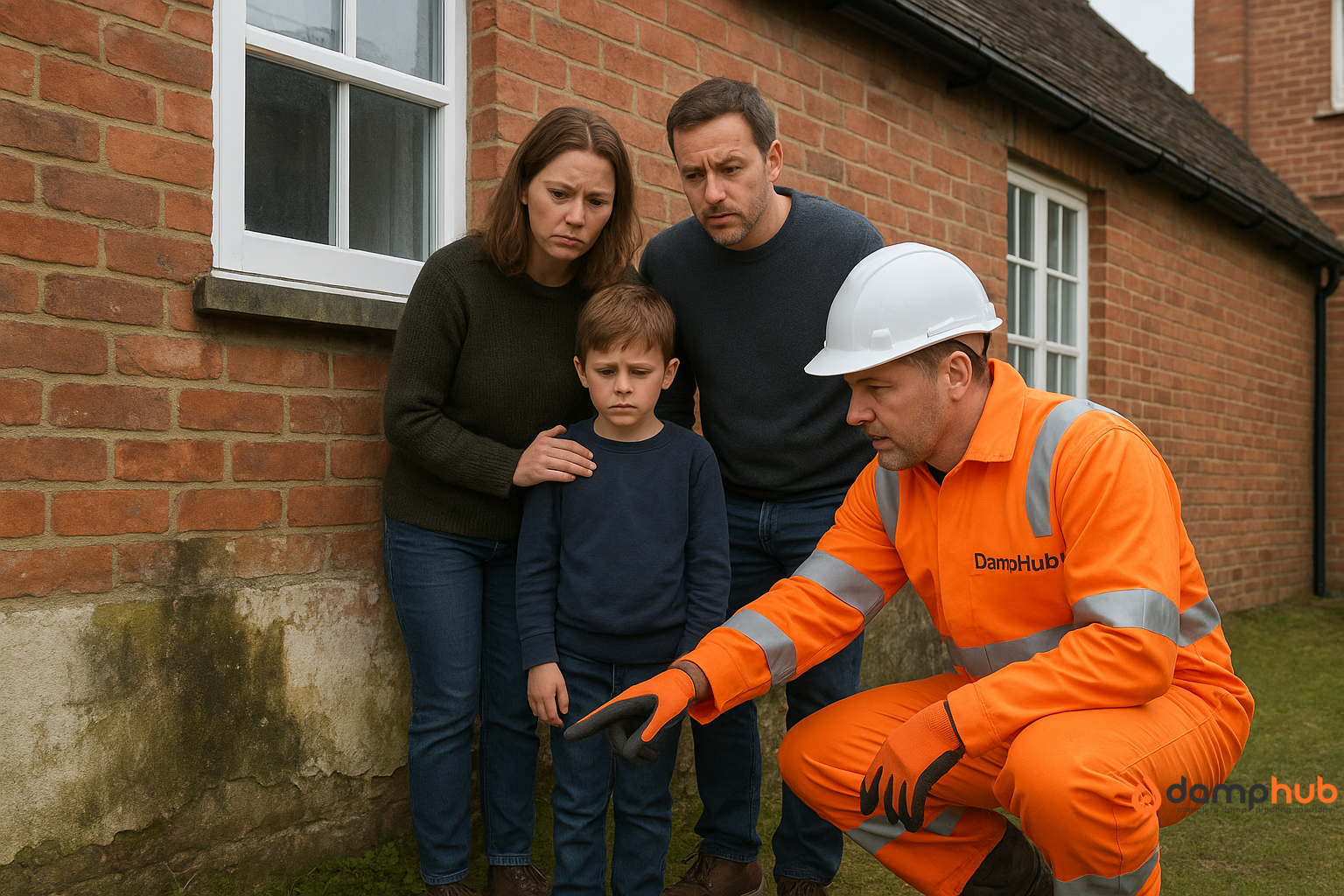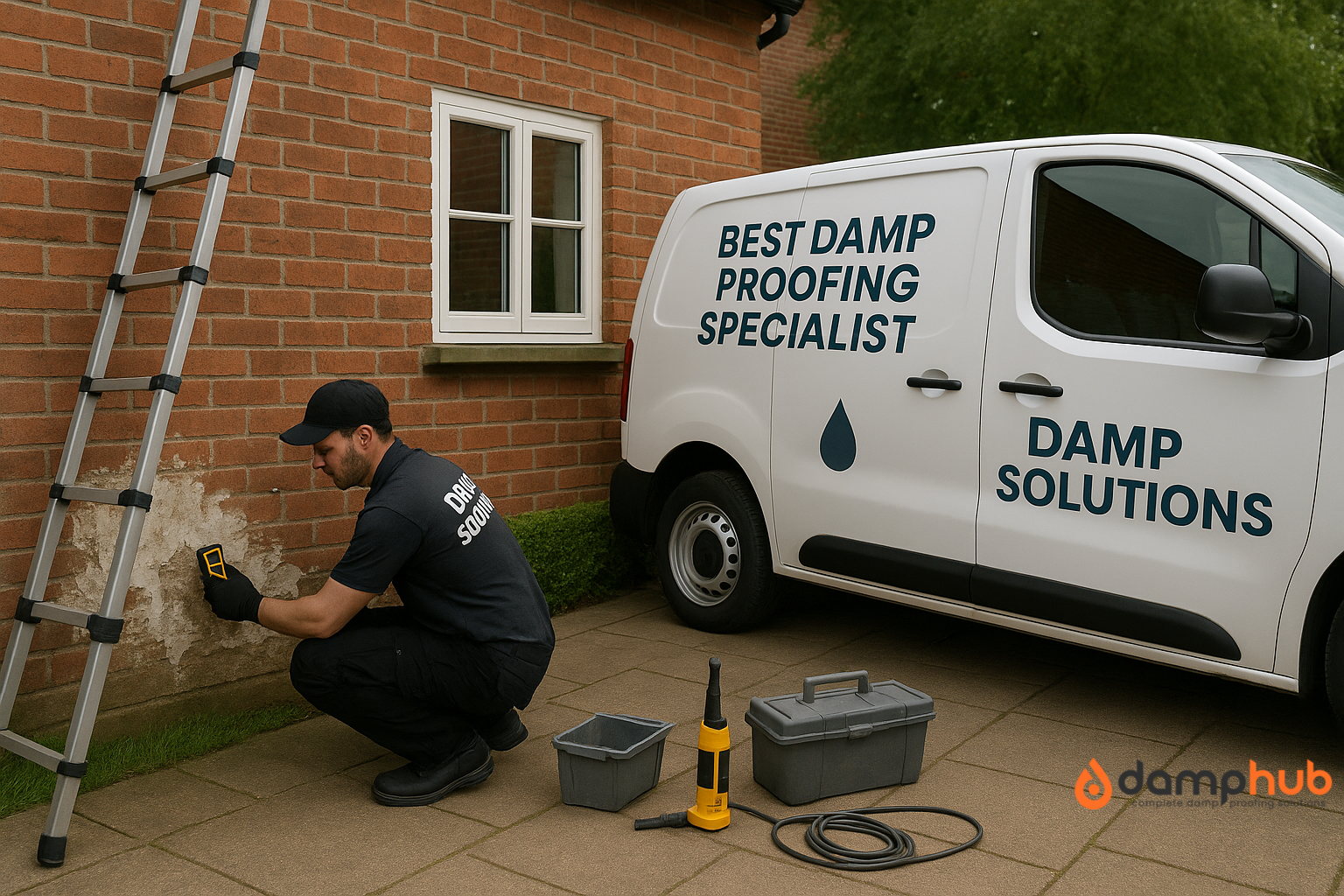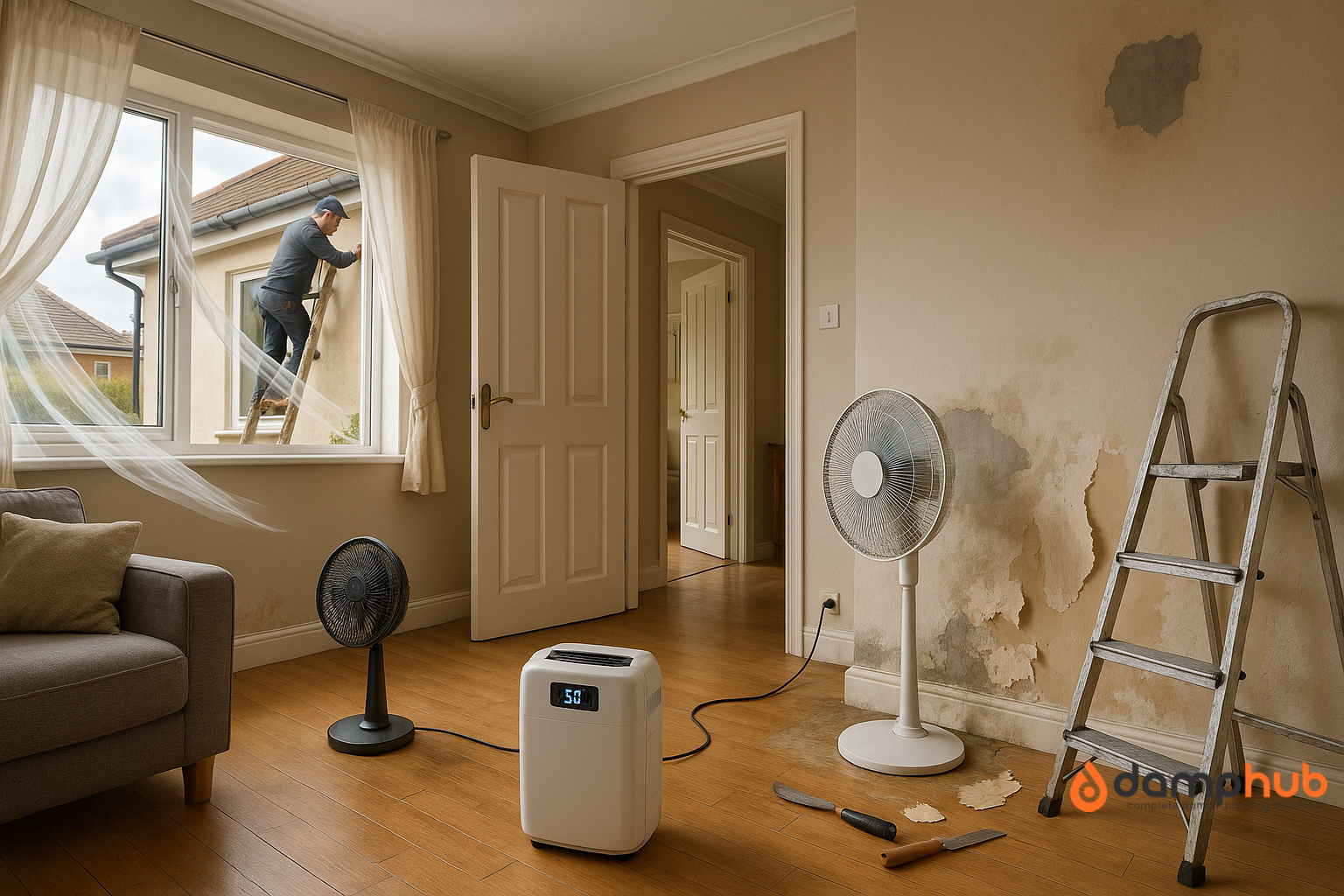
Rising damp occurs when water from the ground moves up through the walls of a building. This happens because bricks and concrete can soak up water like sponges.
Imagine you dip one end of a tissue paper in water. The water slowly moves up the paper. Rising damp works the same way in walls!
If a house does not have a proper barrier under its walls, rainwater from the ground can slowly rise inside the bricks. This can make the walls wet, cause paint to peel, and even grow mould.
Have you ever seen dark, wet patches at the bottom of walls inside old houses?
That is rising damp! It makes homes feel cold and can cause damage over time.
How to Check if You Have Rising Damp?
We’ve talked about it already, but what does rising damp look like? Here are some quick telltale signs that can help you spot the problem early.
1. Damp & Stained Walls
Look near the bottom of the walls, especially around the skirting boards. If you see dark patches that feel cold and damp to the touch, that’s often a warning sign. It’s not a spill or splash from everyday life. It’s usually moisture coming up from the ground.
Over time, this rising damp soaks into the plaster and leaves discoloured stains that creep upwards or sideways. This is common in older homes where the damp-proof course has either failed or was never put in to begin with.

2. Peeling Paint or Wallpaper
If your paint or wallpaper is bubbling, flaking, or lifting — especially low down near skirting boards — it could be a sign of rising damp.
What’s happening is that moisture from the ground is seeping up through the walls and breaking the bond between the plaster and the paint or paper. This trapped dampness pushes outward, causing blisters, cracks, or peeling.
3. White Powder (Salt Deposits) on Walls
That white, chalky powder you sometimes see on lower walls is a common sign of rising damp. As moisture moves up through the wall from the ground, it carries natural salts with it.
When the water evaporates at the surface, it leaves behind these salt deposits. This powdery residue, often found in basements or older homes, shows that moisture is actively passing through the wall — a key giveaway of rising damp.
5. Musty Smell & Mould Growth
A strong musty smell is often the first clue that something’s wrong. That damp scent usually comes from moisture trapped inside the walls.
When damp is rising, the lower parts of the wall stay wet for long periods, creating the perfect conditions for mould.
You might see black or green patches forming near the skirting boards. It’s not just unpleasant — mould can damage surfaces and trigger health issues, especially if left untreated.
What is the Main Cause of Rising Damp?
1. Capillary Action in Porous Materials
- Building materials, especially bricks, and mortar, contain tiny pores (capillaries).
- When these materials come in contact with wet soil, they pull water upward just like a sponge absorbs water.
If you place a dry brick in a shallow pan of water, you will see the water slowly rising into the brick. This is how rising damp occurs in walls.
2. Lack of or Failed Damp-Proof Course (DPC)
- A Damp-Proof Course (DPC) is a damp proof material (often made of plastic, bitumen, or slate) installed at the base of walls to block moisture.
- If a building does not have a DPC (common in pre-1950s homes) or the DPC is damaged or bridged, water can rise through the walls.
In an old Victorian house with a cracked DPC, moisture bypasses the barrier and seeps into the walls, leading to damp patches inside.
3. High Ground Levels Around the Property
- If the soil level outside is higher than the internal floor level, moisture can bypass the DPC and enter the walls.
- This commonly happens when a driveway, patio, or garden bed is built too high against the house.
A homeowner adds a new paved path outside, raising the ground level higher than the damp-proof course. Over time, water begins rising up the walls inside the house.
4. Poor Drainage or Water Accumulation Near Walls
- Blocked or poorly designed drainage causes rainwater to pool around the foundation, increasing water absorption into walls.
- Leaking pipes or gutters can also contribute to excess moisture around the base of a building.
A home with clogged gutters has water constantly dripping near the foundation. This increases moisture in the soil, worsening rising damp inside.
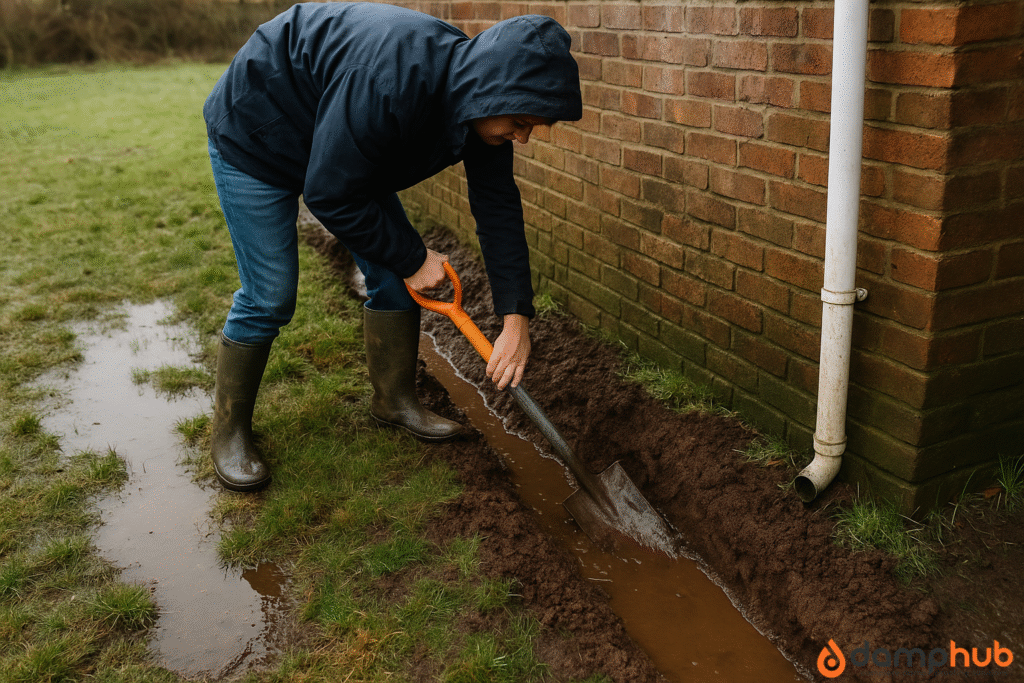
5. Salt Contamination and Hygroscopic Salts
- Groundwater contains dissolved salts (e.g., nitrates and chlorides). As moisture evaporates from the walls, these salts crystallise, causing damage.
- Some salts are hygroscopic, meaning they attract moisture from the air, keeping the wall damp even after the water source is removed.
An old wall with rising damp shows white, powdery salt deposits. Even when dry weather comes, the wall remains damp because the salts keep pulling moisture from the air.
What Damage Can Rising Damp Do?
If not addressed properly and promptly, rising damp is dangerous to your property and health. Let’s find out how:
1) Structural Damage to Buildings
Weakening of Walls and Plaster
A house with rising damp has crumbling plaster on the lower walls. When touched, the plaster feels soft and flaky due to prolonged moisture exposure.
Damage to Paint and Wallpaper
In the living room, the paint near the floor starts to bubble, crack, and peel off, making the walls look untidy.

Rotting Wooden Skirting Boards and Floors
A wooden skirting board near a damp wall begins to warp and decay.
If left unchecked, the moisture spreads, weakening the wooden flooring and causing it to become soft or collapse over time.
It can also lead to dry rot on wall, affecting your home’s aesthetics.

2) Health Issues Due to Mould and Damp Air
Mold Growth and Musty Odor
A child’s bedroom has rising damp, leading to black mould patches near the floor. The room smells musty, making it uncomfortable to sleep in.
Respiratory Problems and Allergies
A family living in a damp home suffers from constant coughing, sneezing, and asthma attacks due to mould spores in the air.
Increased Humidity Leading to Dust Mites
High humidity from rising damp creates the perfect environment for dust mites, which can trigger allergies and skin irritation.
3) Aesthetic and Property Value Damage
Unattractive Appearance
A homebuyer visits a property with rising damp and notices stained, peeling walls. The home looks neglected, making them less interested in purchasing.
Reduced Property Value
A house with rising damp gets a low valuation from an inspector, causing the owner to lose thousands of dollars in resale value.
Expensive Repair Costs
A homeowner ignores rising damp for years. Later, they have to spend $5,000+ on professional damp-proofing, wall repairs, and replacing damaged floors.
How Do You Fix Rising Damp in Your House?
1) Installing or Repairing a Damp-Proof Course (DPC)
A Damp-Proof Course (DPC) is a barrier placed at the base of walls to stop moisture from rising. If a building lacks a DPC or the existing one is damaged, it must be repaired or replaced.

2) Lowering External Ground Levels
If the ground outside is higher than the damp-proof course, moisture can bypass it and rise into the walls. Lowering the soil or paving helps prevent this.
A house has a raised garden bed touching its exterior wall, allowing water to soak into the bricks. By lowering the soil level, the homeowner prevents further damp issues.
How To Fix:
- Remove excess soil or paving that is above the DPC level.
- Ensure at least 150mm (6 inches) of clearance between the DPC and ground level.
3. Improving Drainage
Poor drainage around a building can lead to water accumulation, increasing moisture levels in the walls. Fixing drainage prevents rising damp from getting worse.
How To Fix:
- Repair leaking gutters and pipes that cause water to pool near walls.
- Install French drains (gravel-filled trenches) to redirect water away from the house.
- Ensure proper ground slope so rainwater drains away instead of collecting near walls.
A house with clogged gutters allows rainwater to drip near the foundation, soaking the bricks. After cleaning and repairing the gutter system, the damp problem improves.
4. Using Specialist Damp-Proof Coatings and Plaster
Even after fixing the root cause, walls may still have residual moisture and salt deposits. Damp-proof coatings and plaster help protect against further damage.
How To Fix:
- Damp-resistant plaster prevents moisture from spreading on interior walls.
- Salt-resistant coatings stop salts from forming white, powdery marks (efflorescence).
- Damp-proof paint seals walls to reduce further moisture absorption.
After treating rising damp, a homeowner applies damp-resistant plaster and waterproof paint to prevent future salt stains and peeling paint.
For more detailed guidance on how to treat rising damp, you may want to read our dedicated post on How to Cure Rising Damp in an Old House and How to Treat Rising Damp: A Complete Guide for UK Homeowners.
How to Prevent Rising Damp?
Regularly Check Walls for Early Signs of Damp
Catching damp problems early prevents serious damage and costly rising damp treatment costs.
What to Look For?
- Dark, wet patches near the bottom of walls.
- Peeling paint or bubbling wallpaper.
- White, powdery salt deposits (efflorescence).
- Musty smell or mould growth.
Prevention Tip: Inspect both inside and outside walls at least twice a year, especially after heavy rains.
Maintain Gutters and Drainage Systems
Blocked gutters or poor drainage cause rainwater to collect near walls, increasing moisture levels and leading to rising damp.
How to Maintain Gutters?
- Clean gutters and downpipes regularly to prevent water overflow.
- Fix leaking or broken gutters so water doesn’t drip near walls.
- Ensure water drains away from the house (not towards it).
Prevention Tip: Check and clean gutters at least twice a year (before and after the rainy season).
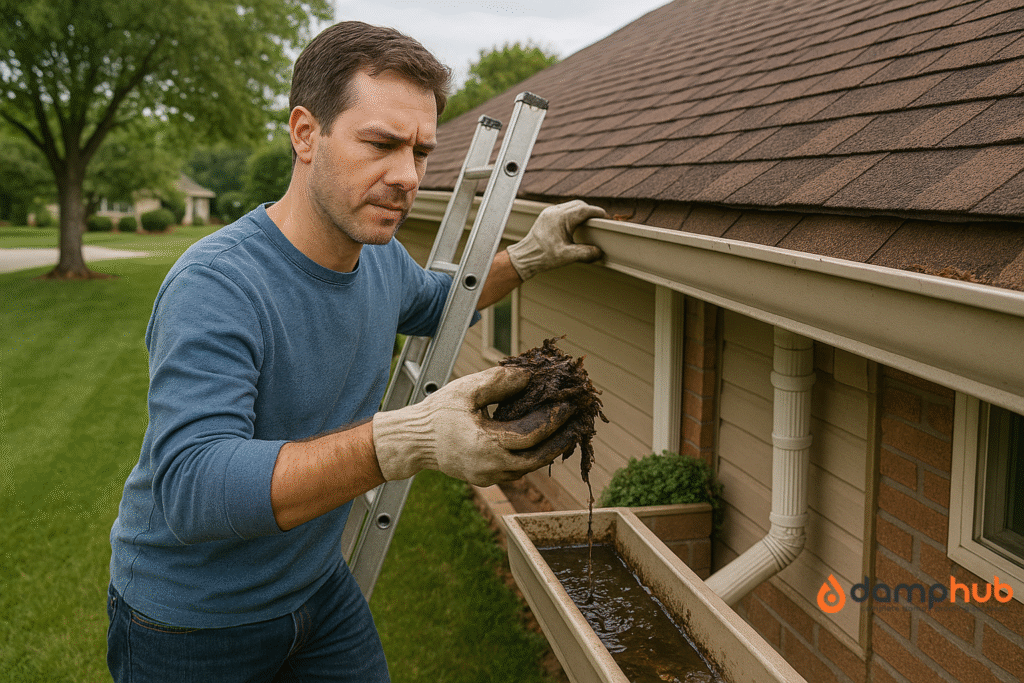
3. Avoid Raising Soil or Paving Above the DPC Level
If the ground level outside is too high, it can bridge the damp-proof course (DPC), allowing moisture to bypass it and enter the walls.
How to Prevent This?
- Ensure at least 150mm (6 inches) of clearance between the DPC and ground level.
- Avoid building raised flower beds, patios, or driveways against exterior walls.
- If necessary, lower the soil or paving to keep the DPC exposed.
A homeowner builds a new paved patio that is level with the house’s floor.
Over time, water seeps into the walls, causing rising damp.
To fix it, they lowered the patio height to expose the DPC, preventing further damp issues.
Prevention Tip: Always check the ground level before laying paving, garden beds, or driveways next to walls.
👉 Related Blog: How to Remove Damp from Walls: The Ultimate Guide
When to Get Professional Help for Rising Damp
While minor damp issues can sometimes be managed with DIY solutions, professional help is needed when the problem is severe, persistent, or affecting the structure of the building.
Here’s when you should call an expert:
When You See Extensive Damage
Signs:
- Large, damp patches cover the walls.
- Peeling paint or wallpaper over a wide area.
- Crumbly, soft plaster falling off.
When You See Extensive Damage
Signs:
- Large damp patches cover the walls.
- Peeling paint or wallpaper over a wide area.
- Crumbly, soft plaster falling off.
2. If There’s Mould or a Musty Smell That Won’t Go Away
Signs:
- Black or green mould growing on walls or skirting boards.
- A strong, musty smell even after cleaning or airing out the room.
- Family members experience coughing, sneezing, or allergies.
3. When Your Damp-Proof Course (DPC) Might Be Failing
Signs:
- A house built before the 1950s without a modern DPC.
- The DPC is cracked, bridged, or missing in certain sections.
- Rising damp symptoms appear despite previous damp-proofing.
4. When DIY Fixes Aren’t Working
Signs:
- You tried ventilating, repainting, or using dehumidifiers, but the damp keeps returning.
- DIY damp-proof paint works temporarily but doesn’t fix the root cause.
- You fixed the drainage and checked the DPC, but the issue persists.
5. Before Buying or Selling a House
Why?
- If a home shows signs of damp, it’s best to get a damp survey before purchasing.
- Rising damp lowers property value, so sellers should fix it before listing.
Who to Call for Help?
🔹 Damp Surveyor: To assess the severity and recommend solutions.
🔹 Damp-Proofing Specialist: To install or repair a DPC and treat damp issues.
🔹 Plumber or Drainage Expert: If poor drainage or leaks are contributing to the damp.
Answering Common Questions About Rising Damp

-
How do you stop rising damp?
To stop rising damp, you need to block the moisture from rising. This is done by installing or repairing a damp-proof course. A common method is to inject a special waterproof cream into holes at the base of the wall.
The cream forms a barrier that stops water from moving upwards. In some cases, other systems like damp-proof membranes or drainage improvements may be needed
-
How do you find the source of rising damp?
Start by looking for signs like peeling paint, salt marks, or damp patches near the bottom of walls. Use a moisture meter to check for high damp levels at floor level.
If moisture readings drop as you go higher up the wall, it’s likely rising damp. Check if your home has a DPC — it should be a thin horizontal layer near the base of the wall. If it’s missing, damaged, or bridged by soil or plaster, that may be the source.
-
How to treat rising damp in an old house?
Older houses may not have a DPC at all. The following is how you can go about it:
Step 1: Remove damaged plaster and let the wall dry.
Step 2: Drill holes along the base of the wall and inject damp-proof cream.
Step 3: Use breathable materials like lime plaster instead of modern gypsum, so moisture can escape.
Step 4: Check the ground outside — the soil should not be higher than the DPC level.
Old houses may also need extra ventilation or improved drainage to stay dry long-term. -
Can you fix rising damp yourself?
You can fix small areas of rising damp yourself by:
– Removing old plaster up to about 1 metre high.
– Drilling holes into the base of the wall (usually 10–12 cm apart).
– Injecting damp-proof cream into the holes to create a water barrier.
– Letting the wall dry fully (this can take weeks).
– Replastering with a damp-resistant plaster mix.For larger areas or structural problems, it’s best to call a professional.
-
What’s the difference between damp and rising damp?
Damp is a general term for any moisture problem in a building.
Rising damp is a specific type where moisture comes from the ground and moves up through the walls.Rising damp usually affects the lower part of the wall and may leave tide marks or white salts.
-
How to get rid of damp on walls permanently?
First, you must find and fix the cause of the damp. For example:
– Rising damp: Install or repair a damp-proof course.
– Penetrating damp: Fix leaks or broken gutters.
– Condensation: Improve ventilation or insulation.Once the cause is fixed, remove damaged plaster and repaint with damp-resistant materials. Regular maintenance helps prevent damp from coming back.
-
How to treat rising damp on floors?
To treat rising damp on floors, first remove affected floor coverings and allow the area to dry.
Apply a damp-proof membrane or chemical damp-proof course to block moisture rising through the floor.
Repair or replace damaged materials like timber or plaster. Finally, improve ventilation to reduce humidity and prevent future damp problems.
-
Can you treat rising damp without removing plaster?
Usually, no. Rising damp often affects the plaster on walls, and to treat it effectively, the damaged plaster needs to be removed so the underlying wall can dry and be treated. Simply treating the surface without removing plaster often leads to recurring problems.
-
Does rising damp go away on its own?
No, rising damp does not go away on its own. Without proper treatment, moisture will continue to rise through the walls, causing damage over time. Professional intervention is needed to fix the source and stop the damp.
-
How long does it take for rising damp to dry out?
Rising damp can take several weeks to months to dry out after treatment, depending on factors like the building materials, ventilation, and climate. Proper removal of moisture sources and repair work speed up drying.
-
What does rising damp look like on a concrete floor?
On a concrete floor, rising damp often shows as damp patches, discoloration, or salt deposits (white powdery marks). You might also notice a musty smell or peeling paint on adjacent walls or skirting boards.


